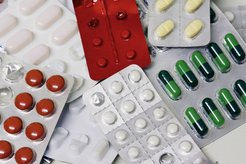The long road to the pharmacy shelf
Any substance that hopes to become the active agent in a potent drug undergoes a selection process similar to those used in the “Next Top Model” or “Idols” TV talent contests. There are three major phases leading to regulatory approval of a drug, a process that can take up to 15 years. The starting point is often a target – a target structure in the body that is associated with a disease and that can provide clues as to a possible active agent that could hinder the course of the illness or influence it positively. One example is a receptor that provides a docking site for a signal molecule that is part of an inflammatory process.

A framework of this kind can be a chemical structure, such as an aminopyrimidine, a ring consisting of two carbon atoms, two nitrogen atoms and an amino group. Various other chemical groups are then attached to these in hopes of improving the active agent. The X-ray crystal structure of the target together with the substance in question is helpful here: “Then you know, for example, how a compound docks into the active pocket of an enzyme. You can see where space remains at which you can link other interactions with the enzyme, for example via hydrogen bonds,” explains Baumann. The key gradually achieves a better fit with the lock – the substance gains in potency and selectivity. The lead is then tested in increasingly complex situations, first in solutions, then in cells and, finally, in live animals. If it passes this hurdle, this is considered the “proof of concept.” The LDC offers its services up to this point.
In the pre-clinical phase, the active agent is scrutinized in greater detail, mainly in tests on animals ranging from mice to monkeys, to establish how it progresses through the metabolism and what kind of side effects it triggers. The clinical phase takes place at the end of the “contest” to find the active agent. The latter then undergoes tests for utility, safety and potency as compared with a placebo in the course of three stages (phase 1 study, phase 2 study, phase 3 study). During these stages, the tests become ever more complex and are carried out on increasing numbers of people. Only when the substance has overcome these hurdles does the selection process come to an end. Then the drug can finally be approved for use in patients.
